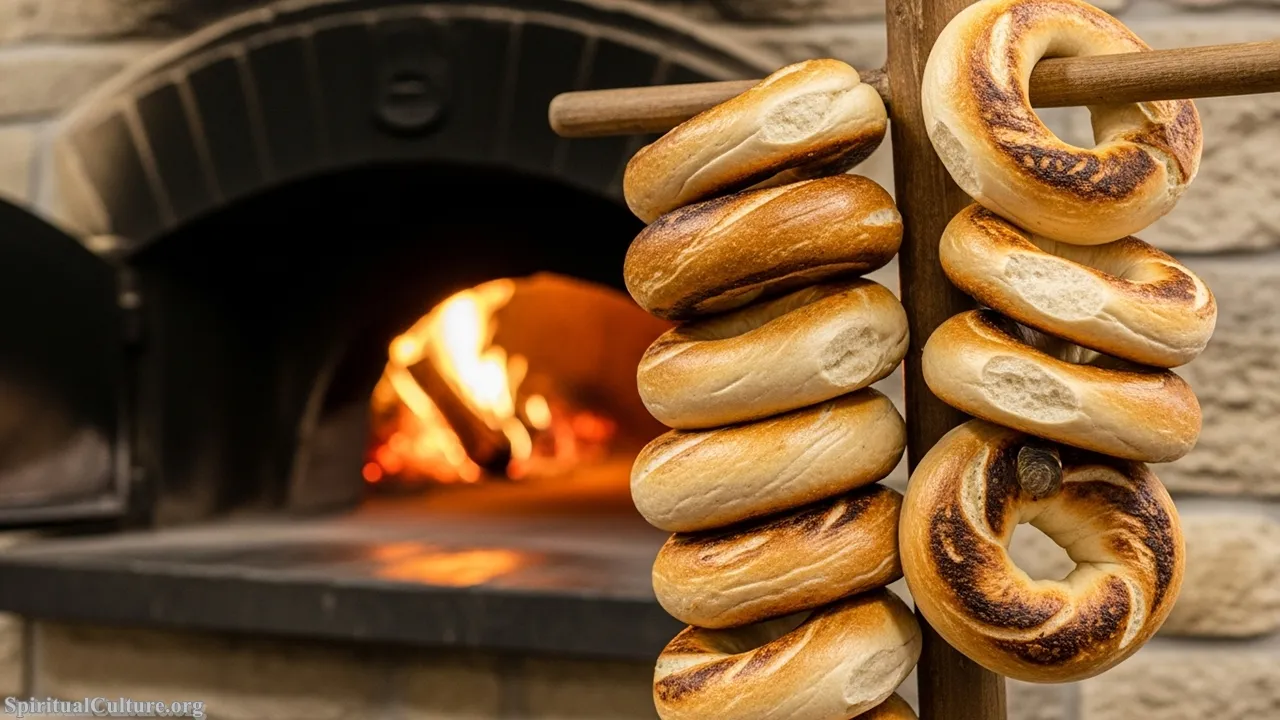Canadian cuisine is far more than a simple collection of recipes; it is a rich tapestry woven from Indigenous ingenuity, French and British colonial influences, and waves of international immigration. The most popular dishes serve as edible artifacts, telling stories of survival, regional identity, and the profound connection between the people and the vast Canadian landscape. These foods are not just consumed; they are celebrated at family gatherings, holiday feasts, and local festivals, cementing their place as pillars of national and provincial heritage.
At Spiritual Culture, our ranking transcends mere taste or contemporary trend. We delve into the historical significance, the depth of cultural adoption, and the spiritual value—the collective sense of identity and belonging—that these foods provide. From the practical necessity of the Indigenous bannock to the celebratory richness of the Quebecois tourtière, each item on this list reflects a layer of the Canadian soul.
This authoritative guide showcases the Top 10 Canadian foods that have achieved undeniable cultural gravitas. Our criteria focus on regional origin, historical root (current as of the Current Time of Writing), and their enduring role in shaping the Canadian cultural niche.
Table of the Top 10 Most Popular Canadian Foods by Cultural Significance
| Rank | Food/Dish | Primary Origin | Cultural/Spiritual Significance |
|---|---|---|---|
| 1 | Maple Syrup | Indigenous/Eastern Woodlands | Purity, Ingenuity, National Symbol (on flag) |
| 2 | Poutine | Quebec (Centre-du-Québec region, 1950s) | Québécois Identity, Comfort, Working-Class Culture |
| 3 | Bannock | Indigenous Peoples (Pre-Contact/Post-Contact) | Survival, Cultural Resilience, Community Gathering |
| 4 | Tourtière | Quebec (French-Canadian) | Holiday Tradition, Family Feast, French Heritage |
| 5 | Butter Tarts | Ontario (Late 19th/Early 20th Century) | Pioneer/Settler Legacy, Domestic Comfort, Regional Pride |
| 6 | Nanaimo Bar | Nanaimo, British Columbia (Post-WWII era) | Post-War Innovation, West Coast Identity, Home Baking Tradition |
| 7 | Montreal-Style Bagel | Montreal, Quebec (Late 19th Century) | Jewish Immigrant Heritage, Artisanal Craftsmanship, Urban Identity |
| 8 | Montreal Smoked Meat | Montreal, Quebec (Late 19th/Early 20th Century) | Jewish Deli Culture, Unique Spice Cure, Culinary Landmark |
| 9 | Saskatoon Berry Pie | Canadian Prairies (Indigenous Staple) | Prairie Bounty, Connection to the Land, Settler Adoption |
| 10 | Peameal Bacon | Toronto, Ontario (Mid-19th Century) | British Preservation Technique, Toronto Market Staple, British Heritage |
#10. Peameal Bacon (Toronto, Ontario)
Peameal bacon, often called Canadian bacon internationally, is a specialty of Toronto, tracing its origins to English immigrant William Davies in the mid-19th century. Unlike standard bacon, it is a lean, wet-cured, unsmoked back bacon, traditionally rolled in ground yellow peas—now typically cornmeal—for preservation. This unique preparation method was born out of a practical need to export pork loins to England, embedding a story of colonial commerce and agricultural resourcefulness within its culinary DNA. It remains a fixture in Toronto’s St. Lawrence Market, serving as a distinct marker of the city’s historical connection to British settlement and global trade.

Its spiritual impact lies in its representation of Toronto’s enduring commercial heart and immigrant adaptation. As a staple of breakfast and brunch across Southern Ontario, Peameal Bacon speaks to the enduring legacy of the pioneers and early merchants who shaped the region’s economy. While humble in appearance, it is a point of culinary pride for the Greater Toronto Area, representing a local culinary innovation that became a key export, reflecting a foundational Canadian value of pragmatic industry.
The moral lesson of Peameal Bacon is one of transformation: taking a basic necessity (pork loin) and through innovative curing and preparation (the peameal/cornmeal coating), creating an elevated local delicacy. Its longevity is a testament to the fact that cultural heritage can be found even in the most practical aspects of daily sustenance, reflecting the lean and resourceful spirit of early Canadian settlers.
Cultural/Spiritual Highlights
- Originates from the preservation needs of 19th-century British immigrant William Davies.
- It is a signature staple of Toronto’s St. Lawrence Market, symbolizing the city’s market history.
- Represents the British influence on central Canadian cuisine.
- Focus: Pragmatism, Commerce, and Regional Identity.
#9. Saskatoon Berry Pie (Canadian Prairies)
The Saskatoon Berry Pie, a staple of the Canadian Prairies—Alberta, Saskatchewan, and Manitoba—highlights a deep, direct connection to the indigenous plant life of the land. The Saskatoon berry, similar to a blueberry but with a distinct, nutty, almond-like flavour, was a crucial part of the diet for Indigenous peoples, used in everything from dried food preparations to daily sustenance. The pie itself emerged from the synthesis of Indigenous ingredients with the European baking traditions brought by settlers, cementing it as a true representation of prairie fusion cuisine.

The spiritual impact of this pie is its deep-rooted association with the bounty of the prairie landscape. It is a celebration of the short but intense summer harvest, evoking a collective sense of gratitude and connection to the vast, fertile plains. The berries’ abundance speaks to the spiritual provision of the earth, and the act of foraging or growing them reinforces the cyclical rhythm of life in this agricultural region. Enjoying the pie is a communion with the soil and the natural heritage of the West.
This dessert offers a reflection on harmony and coexistence: the marriage of the native berry with the settler’s pastry crust symbolizes the blending of cultures on the prairies. Its preservation value lies in reminding Canadians to cherish and utilize native flora, ensuring the knowledge and culinary traditions surrounding this wild fruit continue to thrive for future generations as a taste of pure, unspoiled Canada.
Cultural/Spiritual Highlights
- Named after the Indigenous term misâskwatômina (Saskatoon berry).
- A crucial traditional food for the Indigenous peoples of the Prairies.
- Symbolizes the bounty and natural heritage of Western Canada.
- Focus: Land Connection, Harvest, and Regional Pride.
#8. Montreal Smoked Meat (Montreal, Quebec)
Montreal Smoked Meat is an iconic Quebec deli staple, consisting of beef brisket that is cured, dry-rubbed with spices (such as cracked peppercorns, coriander, garlic, and mustard seeds), smoked, and then steamed to tender perfection. The dish arrived in Montreal in the late 19th and early 20th centuries, brought by Jewish immigrants from Romania and Eastern Europe, who adapted their traditional cured-meat recipes like pastrami. It is almost always served piled high on rye bread with mustard, embodying a culinary tradition of craftsmanship and community within the city’s Jewish quarter.

The spiritual significance of Montreal Smoked Meat is rooted in the narrative of cultural transfer and immigrant resilience. It represents the successful establishment of a distinct Jewish-Canadian deli culture, transforming a European tradition into an essential part of the Montreal identity. The meticulous process of curing and smoking the meat is a ritualistic act of patience and flavour development, mirroring the effort and care required for immigrants to build a new life while preserving their heritage. It is comfort food that tells a history of migration.
This dish serves as a powerful moral lesson on the enrichment of a society through cultural diversity. The flavour, unique to Montreal, is a direct result of the city welcoming new populations who brought their culinary expertise. The ongoing reverence for the few remaining original delis reinforces the importance of preserving culinary landmarks as living monuments to our shared heritage.
Cultural/Spiritual Highlights
- Introduced by Jewish immigrants from Eastern Europe in the late 19th century.
- The process (curing, smoking, steaming) represents culinary craftsmanship and tradition.
- A central icon of Montreal’s deli culture and immigrant history.
- Focus: Immigrant Heritage, Resilience, and Urban Culinary Identity.
#7. Montreal-Style Bagel (Montreal, Quebec)
The Montreal-Style Bagel is a unique baked good distinguished by being boiled in honey-sweetened water before being baked in a wood-fired oven. This technique results in a bagel that is smaller, denser, sweeter, and crispier than its counterparts, particularly the New York bagel. Like smoked meat, the Montreal bagel traces its origins back to Eastern European Jewish immigrants, who established bakeries in the late 19th century, making it a foundational element of the city’s culinary landscape, particularly in areas like Mile End.

This bagel holds deep spiritual significance as an enduring symbol of artisanal purity and community devotion. The unique process—hand-rolled, boiled, and wood-fired—represents a commitment to an older, less industrialized form of food production, honouring the effort of the original bakers. It is food created through ritual, with the wood-fired ovens acting almost as hearths of communal tradition. It connects modern Montrealers to the daily rhythms and simple needs of their immigrant predecessors, offering a taste of history in every bite.
The reflection provided by the Montreal Bagel is one of distinctiveness and pride. It is an acknowledgment that true cultural value often lies in resisting standardization and cherishing unique local methods. Its global recognition affirms that preserving local culinary heritage is vital to maintaining a vibrant and unique cultural identity, reminding us that simple, hand-made food can carry a profound spiritual weight.
Cultural/Spiritual Highlights
- Hand-rolled and boiled in honey-sweetened water before baking.
- A primary cultural marker of the Jewish immigrant community in Montreal.
- Its unique process symbolizes a dedication to traditional, artisanal craftsmanship.
- Focus: Artisanal Purity, Immigrant Tradition, and Urban Distinctiveness.
#6. Nanaimo Bar (Nanaimo, British Columbia)
The Nanaimo Bar is a no-bake dessert consisting of three distinct layers: a base of wafer, coconut, and nut crumbs; a custard-flavoured butter icing; and a top layer of chocolate ganache. Named for the city of Nanaimo on Vancouver Island, British Columbia, this dessert rose to prominence in the post-WWII era when rationing ended and ingredients like butter and sugar became widely available. Its first verified appearance under the name “Nanaimo Bar” was in the 1950s, embodying the spirit of post-war domestic ingenuity and modern convenience.

The spiritual impact of the Nanaimo Bar is tied to its role as a celebration of domestic life and community connection in a period of change. The lack of baking required made it accessible for busy hostesses, symbolizing a new era of ease and leisure. It represents the West Coast’s culinary contribution, standing as a proud counterpoint to the eastern Canadian classics. More profoundly, it signifies the collective memory of a time of prosperity and community gatherings, where a sweet, rich dessert was an essential offering of hospitality.
The bar’s enduring popularity, complete with an “Official Nanaimo Bar Recipe” selected by the city’s mayor in 1986, is a reflection on how local communities can mobilize to preserve and celebrate a piece of their identity. It reminds us that spiritual comfort and cultural significance can be found not just in ancient rituals, but in the simple, shared pleasure of a modern, multi-layered confection, uniting a community under a sweet, recognizable banner.
Cultural/Spiritual Highlights
- A no-bake dessert popularized in the post-WWII era (1950s).
- Named for Nanaimo, British Columbia, cementing West Coast regional identity.
- Symbolizes domestic ingenuity and modern hospitality.
- Focus: Community, Domestic Tradition, and West Coast Pride.
#5. Butter Tarts (Ontario)
Butter Tarts are a quintessential Canadian dessert, particularly associated with Ontario, where their earliest known recipes appeared in the late 19th and early 20th centuries. These small pastries feature a flaky crust filled with a simple, sweet mixture of butter, sugar, syrup, and egg. The precise texture of the filling—ranging from runny and gooey to firm—is a source of passionate, regional debate, reflecting the dish’s deep cultural saturation. Often containing raisins, walnuts, or pecans, the tart is a humble food born out of the practicality of pioneer cooking.

The spiritual value of the Butter Tart is rooted in its embodiment of pioneer comfort and domestic simplicity. It is a food that utilizes essential farm ingredients—butter, eggs, sugar—and evokes the hearth and home of early Canadian settlers. Eating a butter tart is a nostalgic act that connects Canadians to the legacy of their pioneering ancestors, who relied on resourcefulness to create moments of sweetness amid hardship. This simplicity is its genius, making it a powerful, unpretentious symbol of Canadian sweetness and homeliness.
The reflection offered by the Butter Tart is a celebration of the ‘unassuming hero’ in Canadian culture. Despite its humble ingredients, it has become a national icon, inspiring annual festivals and cross-country debates. It teaches that the most culturally significant items are often those that require the least fuss, created out of necessity but sustained by love, embodying the down-to-earth spirit of Canada’s heartland.
Cultural/Spiritual Highlights
- Originates in pioneer/settler cooking tradition in Ontario (c. 1900).
- Its core ingredients reflect the agricultural self-sufficiency of early settlers.
- The national debate over its filling texture (runny vs. firm) underscores its cultural importance.
- Focus: Pioneer Legacy, Domestic Comfort, and Authenticity.
#4. Tourtière (Quebec)
Tourtière is a traditional French-Canadian meat pie, typically filled with spiced minced meat (pork, veal, or beef) and often served during the Christmas and New Year’s holidays. Dating back to the New France colonial era (17th century), this savoury dish is deeply interwoven with the Catholic calendar and the traditions of Quebec. The recipe varies dramatically by family and region, with coastal versions sometimes featuring wild game or fish, making it a highly personal and regionally expressive form of culinary heritage.

The spiritual impact of Tourtière is immense, as it serves as the centrepiece of the French-Canadian Réveillon—the New Year’s Eve feast—and the wider holiday season. It is a ritualistic food, symbolizing family continuity, celebration, and the endurance of French heritage in North America. The shared act of baking and consuming the tourtière is an annual renewal of familial and cultural bonds, providing a profound sense of rootedness and identity for the Quebecois people. It is more than a meal; it is a monument to tradition.
The moral lesson of Tourtière is the vital role of food in the preservation of heritage against the tides of change. By meticulously preparing and passing down these complex, time-consuming recipes, families actively maintain their linguistic and cultural legacy. It encourages reflection on the spiritual power of tradition to keep a distinct culture alive and flourishing, making the tourtière a celebrated anchor of French-Canadian identity.
Cultural/Spiritual Highlights
- A traditional French-Canadian meat pie dating back to the 17th century.
- Central to the Christmas/New Year’s holiday Réveillon feast.
- Symbolizes the endurance of French heritage in North America.
- Focus: Familial Tradition, Cultural Preservation, and French-Canadian Identity.
#3. Bannock (Indigenous Peoples)
Bannock is a simple flatbread made from a flour, water, and fat dough, which can be baked, pan-fried, or deep-fried. While forms of flatbread existed among Indigenous peoples pre-contact, the modern bannock recipe using European wheat flour and leavening agents was adopted out of necessity following the disruption of traditional food sources by European settlement. It quickly became a staple food for many First Nations, Métis, and Inuit communities, transforming a food of colonial necessity into a symbol of resilience and cultural adaptability across Canada.

The profound spiritual significance of Bannock lies in its representation of Indigenous resilience and communal sharing. As a food often prepared over an open fire in natural settings, it holds a connection to the land and the spirit of the wilderness. It is an intrinsic part of powwows, gatherings, and family meals, fostering community and hospitality. Though its ingredients were imposed, the act of making and sharing bannock is now an affirmation of cultural survival and the unbroken spirit of the First Peoples of Canada.
Bannock offers a powerful reflection on Canada’s complex history. It is a reminder of loss, but also of adaptation and the tenacity of Indigenous cultures to reclaim and indigenize imposed elements. For Spiritual Culture, it represents a foundational lesson in spiritual strength: how simple sustenance can transcend its origins to become a celebrated symbol of cultural endurance and hope for reconciliation.
Cultural/Spiritual Highlights
- A staple food for many First Nations, Métis, and Inuit communities.
- Symbolizes cultural resilience and adaptation following colonial influence.
- Focus: Resilience, Community Sharing, and Connection to the Land.
#2. Poutine (Quebec)
Poutine is arguably Canada’s most internationally recognized dish, consisting of crispy French fries, squeaky fresh cheddar cheese curds, and hot brown gravy. Originating in the rural snack bars (cantines) of Quebec’s Centre-du-Québec region in the late 1950s, its creation is disputed by several small towns, yet its birthplace is undeniably Quebec. What began as a humble, working-class snack quickly rose to become a quintessential symbol of Québécois popular culture, spreading across Canada and the world by the 1990s.

The spiritual significance of Poutine lies in its evolution as a symbol of Québécois identity and cultural pride. Initially a source of ridicule, its adoption and celebration by Quebecois people transformed it into an emblem of their unique, unpretentious cultural distinctiveness. It is the ultimate comfort food, providing caloric sustenance and warmth during harsh Canadian winters, a ritualistic act of communal indulgence often associated with late-night camaraderie. Its “messy” nature, as hinted at in its rumoured origin (a “maudite poutine” or “damned mess”), embraces a joyful, unrefined spirit.
Poutine’s story is a moral lesson on accepting and celebrating the messy, authentic parts of one’s culture. It has transcended its origins to become a genuine, if sometimes controversial, national icon, reflecting the youthful, rebellious, and robust spirit of a modern Canada unafraid to own its high-calorie heritage. For Spiritual Culture, it embodies a joyful, celebratory form of cultural bonding.
Cultural/Spiritual Highlights
- Originates in the rural snack bars of Quebec (late 1950s).
- The essential dish for modern Québécois cultural identity.
- Represents working-class culture, comfort, and communal indulgence.
- Focus: Identity, Comfort, and Global Recognition.
#1. Maple Syrup (Indigenous/Eastern Woodlands)
Maple Syrup is not merely a food product; it is a foundational pillar of Canadian heritage, culture, and national identity, which is literally represented on the Canadian flag. The knowledge of tapping the maple tree (primarily the Sugar Maple) and boiling the sap to create a sweet, consumable syrup was practiced by Indigenous peoples in the Eastern Woodlands for centuries before European contact. Settlers quickly adopted this process, recognizing its value as a natural sweetener and a crucial source of sugar. Quebec now produces the vast majority of the world’s maple syrup, cementing its role as a global agricultural and culinary giant.

The spiritual impact of Maple Syrup is unparalleled: it is a potent symbol of purity, ingenuity, and the sacred relationship with the land. The annual “sugaring off” season, where communities gather at a sugar shack (cabane à sucre) to boil sap, is an enduring ritual of renewal and gratitude for nature’s provision. It embodies a deep respect for the Earth, connecting contemporary Canadians to the sustainable practices of the First Nations. The sweetness represents the “liquid gold” of the forest, a divine gift harvested through patience and natural knowledge.
Maple Syrup is the ultimate cultural lesson in symbiosis. It reflects a successful, sustainable partnership between humanity and nature, and between Indigenous knowledge and settler adaptation. Its position at the pinnacle of Canadian cuisine is due to its ancient heritage, its omnipresence as a national symbol, and the collective spiritual gratitude it evokes for the bounty of the Canadian forest. It represents the authentic, sweet heart of Canada.
Cultural/Spiritual Highlights
- The practice of tapping sap was taught by Indigenous Peoples to early settlers.
- Symbolizes purity, ingenuity, and a sacred relationship with the land.
- The Maple Leaf is the primary symbol on the Canadian national flag.
- Focus: National Identity, Sacred Nature, and Ancient Heritage.
Conclusion
From the primal, earth-connected sweetness of Maple Syrup (Rank #1) to the comfort and communal spirit of Poutine (Rank #2), and the resilient, historical weight of Bannock (Rank #3), Canada’s Top 10 foods are a profound expression of its diverse cultural soul. These dishes are more than just sustenance; they are living testaments to the country’s Indigenous roots, the enduring legacy of French and British settlers, and the rich contributions of subsequent immigrant populations.
At Spiritual Culture, we celebrate these foods as symbols of a shared identity—anchors of memory that unite provinces and generations across a vast and diverse land. Each bite is a connection to a specific time, place, and community, reinforcing the profound truth that culture is most powerfully felt when it is tasted, shared, and celebrated. We encourage you to seek out and honour the history in every dish.




